Pesticide usage - soft fruit crops 2018: survey results
Information from a survey of pesticide use on soft fruit crops grown in Scotland during 2018.
This document is part of a collection
2018 Pesticide usage
All strawberries (protected and non-protected crops)
- An estimated 1,175 hectares of strawberries were grown in Scotland in 2018. This consists of 30 ha of non-protected crops and 1,145 ha of protected crop
- 99 per cent of the crop was treated with a pesticide (see Figure 9 for types of pesticides used)
- Pesticide formulations were applied to 24,609 treated hectares with 11,671 kilograms of pesticide applied in total (see summary table)
- Strawberry crops received on average 14.5 applications (Table 1). These included 8.6 fungicide applications and 3.1 insecticide applications (applied to 99 and 97 per cent of the crop area) They also received on average 4.0 biological, 1.6 herbicide/desiccant, 1.7 molluscicide and 2.6 sulphur applications (applied to 68, 44, 39 and 18 per cent respectively)
- Timings of pesticide applications are shown in Figure 10
- Reasons for fungicide use were supplied for 59 per cent of total use; 29 per cent for control of mildew, 28 per cent for control of botrytis, one per cent for red core and root rot and under one per cent for general disease control, crown rot, brown rot, soft rot and rust. The only reasons specified for herbicide/desiccant use were general weed control (11 per cent) and annual meadow grass and crop destruction (under 0.5 per cent)
- Reasons were supplied for 70 per cent of insecticide use; 26 per cent for the control of aphids, 17 per cent for the control of two-spotted spider mites, 12 per cent for caterpillar control, seven per cent for thrips, three per cent for tarsonemid mites, two per cent for vine weevil and capsid control and one per cent for spotted wing drosophila control. Pollen beetle and whitefly control accounted for under 0.5 per cent of use
- Reasons for the use of biological control agents were supplied for 88 per cent of use; 52 per cent was for two-spotted spider mite, 22 per cent for aphids, 13 per cent for vine weevil and <0.5 per cent for thrips. Reasons for the use of biopesticides were supplied for 75 per cent of use; 36 per cent for the control of botrytis, 34 per cent for mildew control, three per cent for two-spotted spider mite and two per cent for thrips control. The only reasons supplied for the use of physical control were aphid and two-spotted spider mite control, each accounting for 12 per cent of use.
- The most common varieties encountered were Sonata and Malling Centenary, accounting for 39 and 20 per cent of the sample area respectively
- 10 per cent of strawberries encountered in the sample were under one year old, 38 per cent were between one and two years old, 9 per cent were over two years old with the remainder unknown
- 73 per cent of the crop sampled was grown in a raised or table top system. 45 per cent of the crop sampled was grown in soil, with the remainder being grown in bags or troughs.
- 77 per cent of the crop sampled was grown using a ground mulch or straw
- 98 per cent of the crop sampled was grown under protection, of this 57 per cent was in permanent tunnels and 43 per cent was in temporary tunnels
- Pollinators were used on 94 per cent of the strawberry crop sampled; pollinators were not used on one per cent and the remainder was unknown. Of the sampled area using pollinators, 76 per cent used bumble bees, 21 per cent used honey bees, two per cent used both bumble bees and honey bees and the remainder used blow flies
- All of the strawberry crops surveyed were harvested in 2018. 98 per cent were for fresh market, one per cent for pick-your-own and one per cent for processing
Summary of pesticide use on all strawberries:
| Pesticide group | Formulation area treated | Weight of pesticides applied | Percentage of crop treated | Most used formulations |
|---|---|---|---|---|
| ha | kg | % | ha | |
| Fungicides | 14,012 | 9,523 | 99 | Fenhexamid (1,905) Fluopyram/trifloxystrobin (1,714) |
| Herbicides/ desiccants | 1,443 | 573 | 44 | Diquat (625) |
| Insecticides/ acaricides | 3,814 | 490 | 97 | Thiacloprid (823) Lambda-cyhalothrin (765) |
| Molluscicides | 773 | 146 | 39 | Metaldehyde (412) Ferric phosphate (361) |
| Sulphur | 549 | 657 | 18 | N/A |
| Biopesticides | 2,895 | 193 | Bacillus subtilis strain QST 713 (1,883) | |
| Biological control agents | 1,078 | N/A | Phytoseiulus persimilis (563) | |
| Physical control | 46 | 90 | 3 | Carbonic acid diamide/urea (46) |
| All pesticides | 24,609 | 11,671 | 99 |
N/A = not applicable
Figure 9 Use of pesticides on all strawberry crops (percentage of total area treated with formulations) - 2018
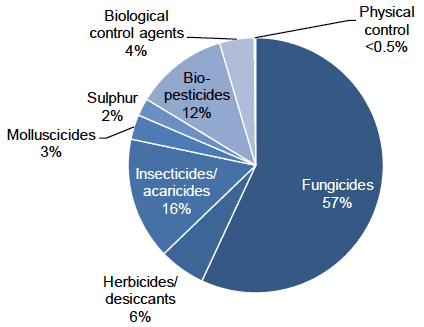
Figure 10 Timings of pesticide applications on all strawberries - 2018
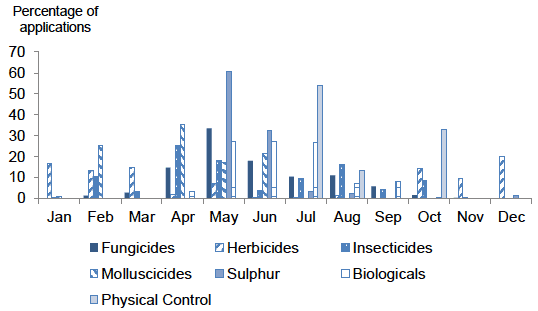
Note: Insecticides include acaricides and herbicides include desiccants. Biologicals include biopesticides and biological control agents.
Non-protected strawberries
- An estimated 30 hectares of non-protected strawberry were grown in Scotland in 2018. This included an estimated three hectares recorded in the mixed and other soft fruit section of the census
- 72 per cent of the crop was treated with a pesticide (see Figure 11 for types of pesticides used)
- Pesticide formulations were applied to 237 treated hectares with 82 kilograms of pesticide applied in total (see summary table below)
- The 72 per cent of non-protected strawberry crop treated with a pesticide received on average 8.0 spray applications (Table 1). These included 4.7 fungicide applications, 2.8 herbicide/desiccant applications, 2.0 biological applications, one insecticide and one mollusicide application (applied to 71, 52, 25, 38 and 20 per cent of the crop respectively)
- Timings of pesticide applications are shown in Figure 12
- The most common variety encountered was Symphony, accounting for 50 per cent of the sample area surveyed
Summary of pesticide use on non-protected strawberries:
| Pesticide group | Formulation area treated | Weight of pesticides applied | Percentage of crop treated | Most used formulations |
|---|---|---|---|---|
| ha | kg | % | ha | |
| Fungicides | 147 | 59 | 71 | Fenhexamid (43) |
| Herbicides/ desiccants | 58 | 21 | 52 | Diquat (21) |
| Insecticides/ acaricides | 11 | <0.5 | 38 | Lambda-cyhalothrin (11) |
| Molluscicides | 6 | 1 | 20 | Ferric phosphate (6) |
| Biological control agents | 15 | N/A | Steinernema feltiae (15) | |
| All pesticides | 237 | 82 | 72 |
N/A = not applicable
Figure 11 Use of pesticides on non-protected strawberries (percentage of total area treated with formulations) - 2018
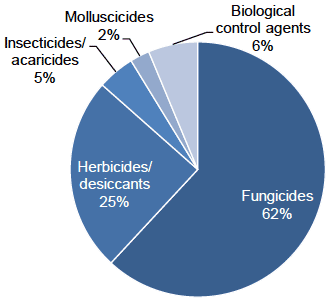
Figure 12 Timings of pesticide applications on non-protected strawberries - 2018
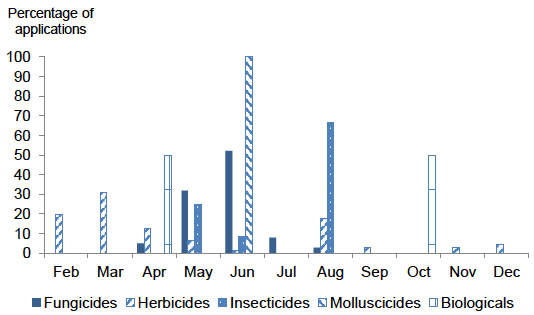
Note: Insecticides include acaricides and herbicides include desiccants
Protected strawberries
- An estimated 1,145 hectares of protected strawberry were grown in Scotland in 2018, including 39 hectares of multi-cropping. Based on the ratio encountered in the sample, it is estimated that 65 per cent of the crop was semi-protected (grown under temporary tunnels) and 35 per cent permanently protected (grown in permanent tunnels or glasshouses)
- All of the crop was treated with a pesticide (see Figure 13 for types of pesticides used)
- Pesticide formulations were applied to 24,372 treated hectares with 11,590 kilograms of pesticides applied in total (see summary table below)
- Protected strawberry crops received on average 14.6 pesticide applications (Table 1). These included 8.7 fungicide applications, 4.1 biological applications, 3.1 insecticide applications, 2.6 sulphur applications, 1.7 molluscicide applications and 1.5 herbicide/desiccant applications (applied to 100, 69, 99, 18, 39 and 44 per cent of the crop respectively)
- The timing of pesticide applications is shown in Figure 14
- The most common varieties encountered were Sonata and Malling Centenary, accounting for 39 per cent and 20 per cent of the sample area respectively
Summary of pesticide use on protected strawberries:
| Pesticide group | Formulation area treated | Weight of pesticides applied | Percentage of crop treated | Most used formulations |
|---|---|---|---|---|
| ha | kg | % | ha | |
| Fungicides | 13,865 | 9,464 | 100 | Fenhexamid (1,862) Fluopyram/trifloxystrobin (1,714) |
| Herbicides/ desiccants | 1,385 | 552 | 44 | Diquat (604) |
| Insecticides/ acaricides | 3,803 | 490 | 99 | Thiacloprid (823) Lambda-cyhalothrin (754) |
| Molluscicides | 767 | 145 | 39 | Metaldehyde (412) Ferric phosphate (355) |
| Sulphur | 549 | 657 | 18 | N/A |
| Biopesticides | 2,895 | 193 | Bacillus subtilis strain QST 713 (1,883) | |
| Biological control agents | 1,063 | N/A | Phytoseiulus persimilis (563) | |
| Physical control | 46 | 90 | 3 | Carbonic acid diamide/urea (46) |
| All pesticides | 24,372 | 11,590 | 100 |
N/A = not applicable
Figure 13 Use of pesticides on protected strawberries (percentage of total area treated with formulations) - 2018
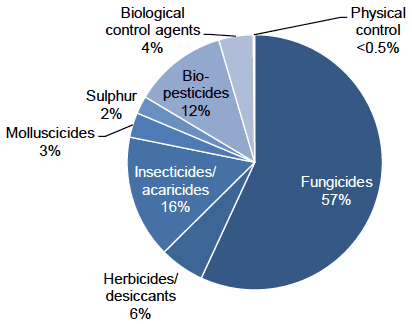
Figure 14 Timings of pesticide applications on protected strawberries - 2018
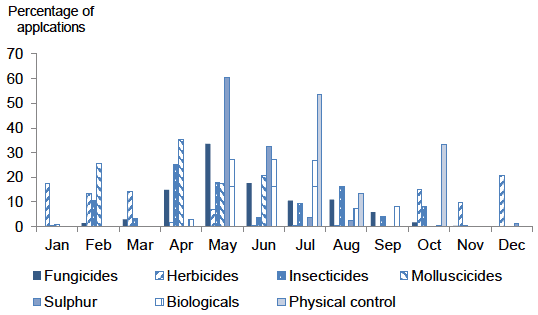
Note: Insecticides include acaricides and herbicides include desiccants. Biologicals include biopesticides and biological control agents
All raspberries (protected and non-protected crops)
- An estimated 276 hectares of raspberries were grown in Scotland in 2018. This consists of 113 hectares of non-protected crops and 162 hectares of protected crop
- 77 per cent of the crop was treated with a pesticide (See Figure 15 for the types of pesticides used)
- Pesticide formulations were applied to 2,005 treated hectares with 765 kilograms of pesticides applied in total (see summary table)
- The 77 per cent of raspberry crop treated with a pesticide received on average 7.1 pesticide sprays (Table 1). These included 4.4 fungicide applications, 2.6 insecticide applications, and 1.9 herbicide/desiccant applications (applied to 75, 68 and 48 per cent of the crop respectively)
- Timings of pesticide applications are shown in Figure 16
- Reasons for fungicide applications were supplied for 57 per cent of total use; 41 per cent was for control of botrytis, five per cent for general disease control, four per cent for cane diseases, three per cent for mildew, two per cent for rust and one per cent for brown rot and root rot
- Reasons for herbicide/desiccant applications on raspberries were supplied for 39 per cent of use; 20 per cent was for general weed control and six per cent for annual grass weeds. Sucker control, annual meadow grass and annual broad-leaved weeds each accounted for four per cent of use; crop destruction accounted for one per cent of use
- Reasons were supplied for 57 per cent of insecticide use; 31 per cent was for aphid control, 11 per cent for two-spotted spider mite, five per cent for raspberry beetle, four per cent for raspberry cane midge, three per cent for caterpillars, two per cent for thrips and one per cent for leaf curling midge
- No reasons were supplied for the use of biological control agents. Reasons were supplied for 39 per cent of biopesticide use; 21 per cent was for two-spotted spider mite and 18 per cent for caterpillar control. All use of physical control was for the control of aphids
- The most common variety encountered was Driscoll Maravilla, accounting for 17 per cent of the sample area
- 28 per cent of the raspberries encountered in the sample were under two years old, 45 per cent were between two and five years old and seven per cent were over five years old. The age of the remainder was unknown
- 55 per cent of the crop sampled was grown in pots and 45 per cent was grown directly in the soil
- 37 per cent of the crop encountered was grown using a ground mulch
- 17 per cent of the raspberry crop sampled was grown outdoors, 39 per cent were in temporary tunnels and 43 per cent was grown under permanent tunnels
- Pollinators were used on 77 per cent of the raspberry crops surveyed; five per cent used no pollinators with the remainder unknown. Of the sampled area using pollinators, 74 per cent were bumble bees, eight per cent were honey bees and 18 per cent used both bumble bees and honey bees
- 98 per cent of the raspberry crops surveyed were harvested in 2018. 86 per cent were for fresh market, eight per cent for processing and six per cent for pick-your-own
Summary of pesticide use on all raspberries:
| Pesticide group | Formulation area treated | Weight of pesticides applied | Percentage of crop treated | Most used formulations |
|---|---|---|---|---|
| ha | kg | % | ha | |
| Fungicides | 1,005 | 566 | 75 | Fenhexamid (349) |
| Herbicides/ desiccants | 391 | 107 | 48 | Diquat (136) Carfentrazone-ethyl (107) |
| Insecticides/ acaricides | 576 | 34 | 68 | Thiacloprid (197) Abamectin (184) |
| Sulphur | 12 | 47 | 4 | N/A |
| Biopesticides | 9 | 3 | Bacillus amyloliquefaciens strain D747 (5) | |
| Biological control agents | 7 | N/A | Steinernema kraussei (5) | |
| Physical control | 4 | 7 | 2 | Carbonic acid diamide/urea (4) |
| All pesticides | 2,005 | 765 | 77 |
N/A = not applicable
Figure 15 Use of pesticides on all raspberries (percentage of total area treated with formulations) - 2018
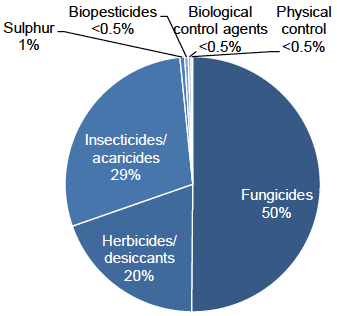
Figure 16 Timings of pesticide applications on all raspberries - 2018
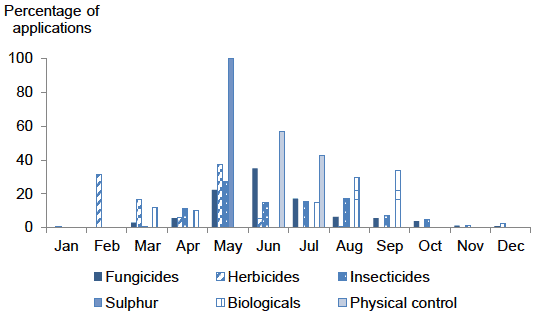
Note: Insecticides include acaricides and herbicides include desiccants. Biologicals include biopesticides and biological control agents
Non-protected raspberries
- An estimated 113 hectares of non-protected raspberries were grown in Scotland in 2018. This included an estimated four hectares recorded in the mixed and other crop category in the census
- 44 per cent of the crop was treated with a pesticide (see Figure 17 for types of pesticides used)
- Pesticide formulations were applied to 501 treated hectares with 199 kilograms of pesticide applied in total (see summary table below)
- The 44 per cent of the non-protected raspberry crop treated with a pesticide received on average 6.0 pesticide sprays (Table 1). These included 3.7 fungicide applications, 2.4 herbicide/desiccant applications, 1.3 insecticide applications and 1.0 sulphur applications (applied to 40, 44, 27 and 10 per cent of the crop respectively)
- Timings of pesticide applications are shown in Figure 18
- Glen Ericht was the most common variety encountered, accounting for 40 per cent of the area sampled
Summary of pesticide use on non-protected raspberries:
| Pesticide group | Formulation area treated | Weight of pesticides applied | Percentage of crop treated | Most used formulations |
|---|---|---|---|---|
| ha | kg | % | ha | |
| Fungicides | 257 | 106 | 40 | Fenhexamid (119) |
| Herbicides/ desiccants | 193 | 43 | 44 | Diquat (59) Isoxaben (50) |
| Insecticides/ acaricides | 40 | 3 | 27 | Thiacloprid (23) |
| Sulphur | 12 | 47 | 10 | N/A |
| All pesticides | 501 | 199 | 44 |
N/A = not applicable
Figure 17 Use of pesticides on non-protected raspberries (percentage of total area treated with formulations) - 2018
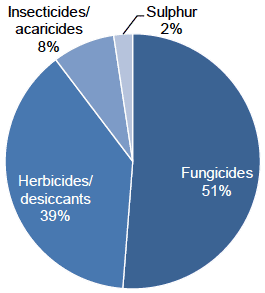
Figure 18 Timings of pesticide applications on non-protected raspberries - 2018
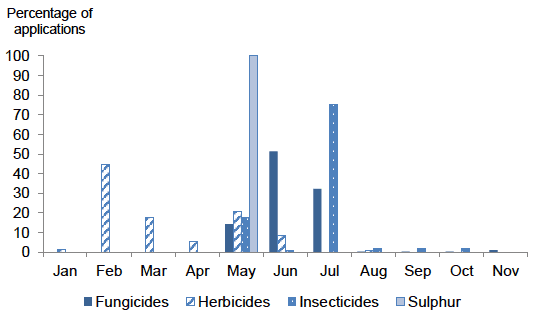
Note: Insecticides include acaricides and herbicides include desiccants
Protected raspberries
- An estimated 162 hectares of protected raspberries were grown in Scotland in 2018. Based on the ratio encountered in the sample, it is estimated that 47 per cent of the crop was semi-protected (grown under temporary tunnels) and 53 per cent was permanently protected (grown in permanent tunnels or glasshouses)
- All of the crop was treated with a pesticide (see Figure 19 for types of pesticides used)
- Pesticide formulations were applied to 1,504 treated hectares with 566 kilograms of pesticides applied in total (see summary table below)
- The protected raspberry crop received on average 7.4 pesticide applications (Table 1). These included 4.6 fungicide applications, 2.9 insecticide applications and 1.6 herbicide/desiccant applications (applied to 99, 96 and 51 per cent of the crop respectively)
- Timings of pesticide applications are shown in Figure 20
- The most common variety encountered was Driscoll Maravilla, accounting for 20 per cent of the sample area
Summary of pesticide use on protected raspberries:
| Pesticide group | Formulation area treated | Weight of pesticides applied | Percentage of crop treated | Most used formulations |
|---|---|---|---|---|
| ha | kg | % | ha | |
| Fungicides | 749 | 461 | 99 | Fenhexamid (231) |
| Herbicides/ desiccants | 199 | 64 | 51 | Carfentrazone-ethyl (83) Diquat (76) |
| Insecticides/ acaricides | 536 | 31 | 96 | Abamectin (184) Thiacloprid (174) |
| Biopesticides | 9 | 3 | Bacillus amyloliquefaciens strain D747 (5) | |
| Biological control agents | 7 | N/A | Steinernema kraussei (5) | |
| Physical control | 4 | 7 | 3 | Carbonic acid diamide/urea (4) |
| All pesticides | 1,504 | 566 | 100 |
N/A = not applicable
Figure 19 Use of pesticides on protected raspberries (percentage of total area treated with formulations) - 2018
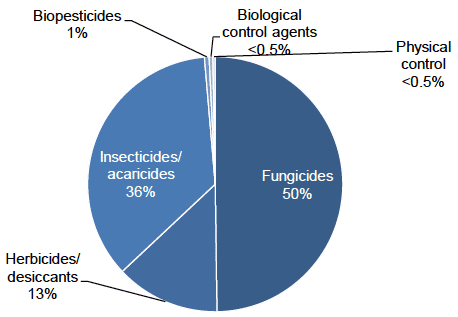
Figure 20 Timings of pesticide applications on protected raspberries - 2018
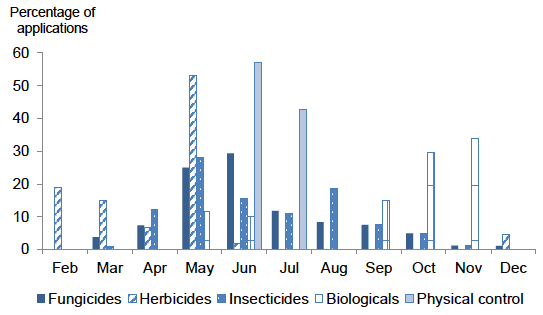
Note: Insecticides include acaricides and herbicides include desiccants. Biologicals includes biopesticides and biological control agents
Blackcurrants
- The total estimated area of blackcurrants grown in Scotland in 2018 was 282 hectares. This includes three hectares which were included in the mixed and other soft fruit census category
- 99 per cent of the cop was treated with a pesticide (see Figure 21 for types of pesticides used)
- Pesticide formulations were applied to 3,335 treated hectares with 4,333 kilograms of pesticide applied in total (see summary table below)
- The 99 per cent of blackcurrant crop treated with a pesticide received on average 6.6 pesticide applications (Table 1). These included 3.9 fungicide applications, 2.6 insecticide applications, 2.0 sulphur applications and 1.5 herbicide/desiccant applications (applied to 97, 98, 91 and 63 per cent of the crop respectively)
- Timings of pesticide applications are shown in Figure 22
- 40 per cent of herbicide/desiccant use was for general weed control, with the remainder unknown. Reasons were provided for less than one per cent of fungicide and insecticide use
- The most common variety encountered was Ben Kilbreck, accounting for 43 per cent of the area sampled
- 42 per cent of blackcurrants encountered were five years old or less, one per cent were between six and 10 years old and under one per cent were older than 10 years with the remainder unknown
- All of the blackcurrant crops sampled were grown in the soil without protection
- 99 per cent of the blackcurrant crops surveyed were harvested in 2018
- 99 per cent of the blackcurrant crops harvested were for processing, and under one per cent for fresh market and pick-your-own
Summary of pesticide use on blackcurrants:
| Pesticide group | Formulation area treated | Weight of pesticides applied | Percentage of crop treated | Most used formulations |
|---|---|---|---|---|
| ha | kg | % | ha | |
| Fungicides | 1,219 | 585 | 97 | Kresoxim-methyl (178) Cyprodinil/fludioxonil (172) |
| Herbicides/ desiccants | 698 | 326 | 63 | Pendimethalin (174) Diquat (174) Flufenacet/metribuzin (171) |
| Insecticides/ acaricides | 896 | 69 | 98 | Thiacloprid (529) |
| Sulphur | 522 | 3,353 | 91 | N/A |
| All pesticides | 3,335 | 4,333 | 99 |
N/A = not applicable
Figure 21 Use of pesticides on blackcurrants (percentage of total area treated with formulations) - 2018
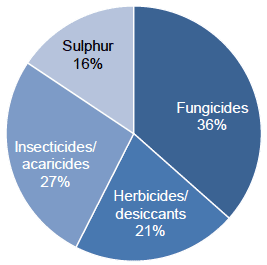
Figure 22 Timings of pesticide applications on blackcurrants - 2018
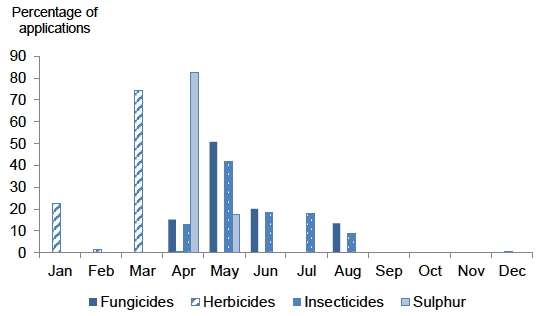
Note: insecticides include acaricides and herbicides include desiccants
All other soft fruit crops (protected and non-protected crops)
- An estimated 356 hectares of other soft fruit was grown in Scotland in 2018. This consists of 139 hectares of non-protected crop and 218 hectares of protected crop
- The crops encountered in this category were blueberry, blackberry, gooseberry and redcurrant as well as minor crops; aronia, honeyberry, japanese wineberry, jostaberry, loganberry, tayberry, tummelberry, whitecurrant and worcesterberry
- 78 per cent of the other soft fruit crop was treated with a pesticide (see Figure 23 for types of pesticides used)
- Pesticide formulations were applied to 1,838 treated hectares with 594 kilograms of pesticide applied in total (see summary table below)
- The 78 per cent of the crop treated with a pesticide received on average 5.3 pesticide applications (Table 1) These included 2.9 insecticide applications, 2.8 fungicide applications, 1.5 herbicide/desiccant applications and one molluscicide application (applied to 62, 66, 29 and 14 per cent of the crop respectively)
- Timings of pesticide applications are shown in Figure 24
- Reasons were supplied for 45 per cent of fungicide use; 25 per cent was for botrytis control, 10 per cent was for mildew, six per cent was for general disease control, two per cent for rust and one per cent for cane blight
- Reasons were provided for 43 per cent of herbicide/desiccant use; 40 per cent was for general weed control and three per cent for annual grass weeds
- Reasons were supplied for 82 per cent of insecticide use; 39 per cent was for aphid control, 21 per cent for caterpillar control, nine per cent for capsids, four per cent for gall midge, two per cent each for blackberry mite, two-spotted spider mite, raspberry leaf and bud mite and sawfly, one per cent for general pests
- All biopesticide use was for botrytis, 18 per cent of the use of biological control agents was for vine weevil and 18 per cent was for raspberry leaf and bud mite
- 48 per cent of other soft fruit crops sampled were five years old or less, 30 per cent were six to 10 years old, two per cent were over 10 years old and 20 per cent of the crop were an unknown age
- 53 per cent of the other soft fruit crops surveyed was grown in the soil and 47 per cent was grown in pots
- 11 per cent of the crop was grown outdoors, 56 per cent was grown under temporary tunnels and 33 per cent was grown under permanent protection
- 56 per cent of the sampled crop was grown using a ground mulch
- Pollinators were used on 83 per cent of the other soft fruit crops sampled, 12 per cent had no pollinators and the remainder was unknown. Of the sampled area using pollinators, 93 per cent were bumble bees, seven per cent were both bumble bees and honey bees and under one per cent were honey bees
- 98 per cent of the crops surveyed were harvested in 2018. Of the crops harvested, 97 per cent was for fresh market, two per cent was for processing and one per cent was for pick-your-own
Summary of pesticide use on all other soft fruits:
| Pesticide group | Formulation area treated | Weight of pesticides applied | Percentage of crop treated | Most used formulations |
|---|---|---|---|---|
| ha | kg | % | ha | |
| Fungicides | 675 | 342 | 66 | Cyprodinil/fludioxonil (186) Fenhexamid (152) |
| Herbicides/ desiccants | 361 | 192 | 29 | Diquat (75) |
| Insecticides/ acaricides | 687 | 53 | 62 | Thiacloprid (257) |
| Molluscicides | 50 | 4 | 14 | Metaldehyde (50) |
| Sulphur | 3 | 2 | 1 | N/A |
| Biopesticides | 17 | 2 | Bacillus subtilis strain QST 713 (17) | |
| Biological control agents | 44 | N/A | Steinernema kraussei (19) Steinernema feltiae (15) |
|
| All pesticides | 1,838 | 594 | 78 |
N/A = not applicable
Figure 23 Use of pesticides on all other soft fruit crops (percentage of total area treated with formulations) - 2018
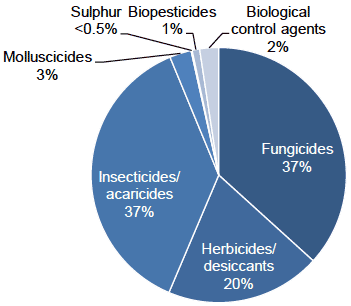
Figure 24 Timings of pesticide applications on all other soft fruit crops - 2018
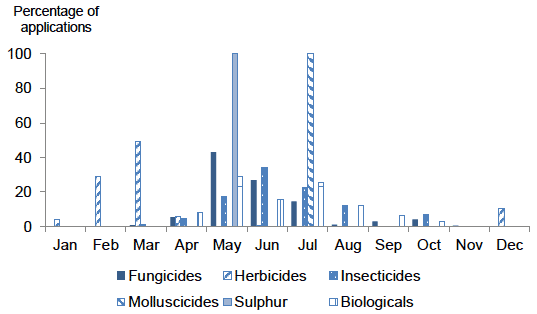
Note: Insecticides include acaricides and herbicides include desiccants. Biologicals includes biopesticides and biological control agents
Non-protected other soft fruit crops
- An estimated area of 139 hectares of non-protected other soft fruit crops were grown in Scotland in 2018
- The crops encountered in this category were blueberry, blackberry, gooseberry and redcurrant as well as the minor crops aronia, honeyberry, japanese wineberry, jostaberry, loganberry, tayberry, tummelberry, whitecurrant and worcesterberry
- 44 per cent of the crop was treated with a pesticide (see Figure 25 for the types of pesticides used)
- Pesticide formulations were applied to 485 treated hectares with 191 kilograms of pesticide applied in total (see summary table below)
- The 44 per cent of the non-protected other soft fruit crop received on average 5.2 pesticide applications (Table 1). These applications included 3.9 fungicide applications, 1.7 herbicide/desiccant applications and 1,1 insecticide applications (applied to 38, 43 and 17 per cent of the crop area)
- The timings of pesticide applications are shown in Figure 26)
Summary of pesticide use on non-protected other soft fruit:
| Pesticide group | Formulation area treated | Weight of pesticides applied | Percentage of crop treated | Most used formulations |
|---|---|---|---|---|
| ha | kg | % | ha | |
| Fungicides | 209 | 69 | 38 | Fenpropimorph (63) |
| Herbicides/ desiccants | 243 | 117 | 43 | Isoxaben (49) Pendimethalin (48) Diquat (41) |
| Insecticides/ acaricides | 26 | 3 | 17 | Thiacloprid (10) |
| Sulphur | 3 | 2 | 2 | N/A |
| Biopesticides | 4 | <0.5 | Bacillus subtilis strain QST 713 (4) | |
| All pesticides | 485 | 191 | 44 |
N/A = not applicable
Figure 25 Use of pesticides on non-protected other soft fruit crops (percentage of total area treated with formulations) - 2018
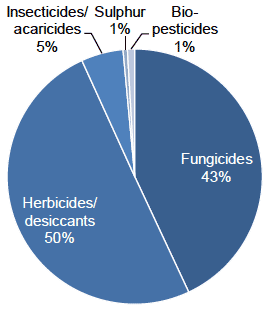
Figure 26 Timings of pesticide applications on non-protected other soft fruit crops - 2018
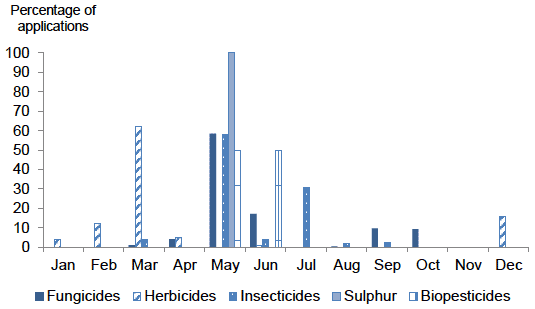
Note: Insecticides include acaricides and herbicides include desiccants
Protected other soft fruit crops
- The total estimated area of protected other soft fruit crops in 2018 was 218 hectares. It is estimated that 71 per cent of the crop was semi-protected (grown under temporary tunnels) with 29 per cent grown under permanent tunnels or glasshouses
- The crops encountered in this category were blueberry, blackberry, gooseberry and redcurrant
- All of the crop area was treated with a pesticide (see Figure 27 for types of pesticides used)
- Pesticide formulations were applied to 1,352 treated hectares with 403 kilograms of pesticide applied in total (see summary table below)
- The protected other soft fruit crop received on average 5.3 pesticide applications (Table 1). These applications included 3.2 insecticide applications, 2.5 fungicide applications, 1.8 biological applications, 1.2 herbicide/desiccant applications and one molluscicide applications (applied to 91, 85, 14, 20 and 23 per cent of the crop)
- The timings of pesticide applications are shown in Figure 28
Summary of pesticide use on protected other soft fruits:
| Pesticide group | Formulation area treated | Weight of pesticides applied | Percentage of crop treated | Most used formulations |
|---|---|---|---|---|
| ha | kg | % | ha | |
| Fungicides | 466 | 274 | 85 | Cyprodinil/fludioxonil (169) |
| Herbicides/ desiccants | 118 | 75 | 20 | Diquat (34) Napropamide (33) |
| Insecticides/ acaricides | 661 | 49 | 91 | Thiacloprid (247) |
| Molluscicides | 50 | 4 | 23 | Metaldehyde (50) |
| Biopesticides | 13 | 1 | Bacillus subtilis strain QST 713 (13) | |
| Biological control agents | 44 | N/A | Steinernema kraussei (19) Steinernema feltiae (15) |
|
| All pesticides | 1,352 | 403 | 100 |
N/A = not applicable
Figure 27 Use of pesticides on protected other soft fruit crops (percentage of total area treated with formulations) - 2018
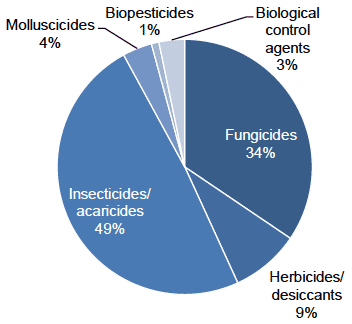
Figure 28 Timings of pesticide applications on protected other soft fruit crops - 2018
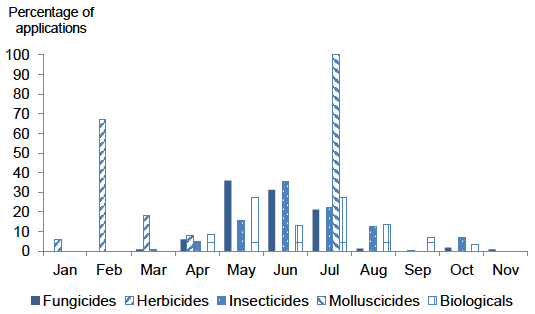
Note: Insecticides include acaricides and herbicides include desiccants. Biologicals includes biopesticides and biological control agents
Contact
Email: psu@sasa.gov.scot
There is a problem
Thanks for your feedback